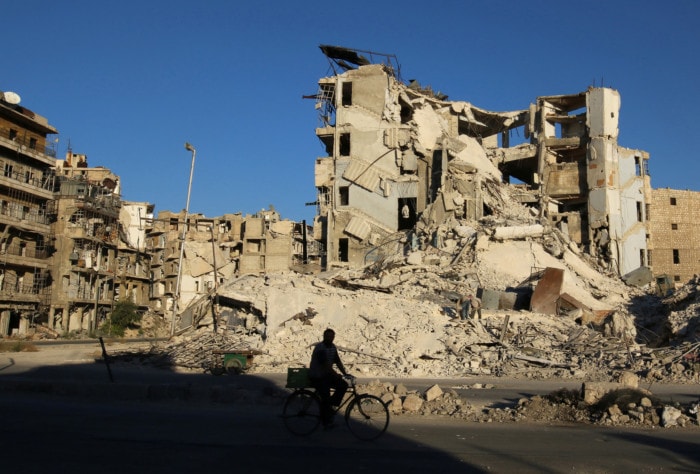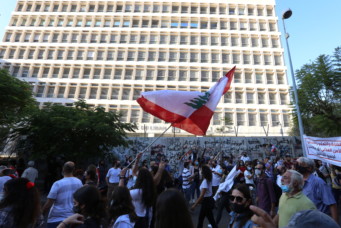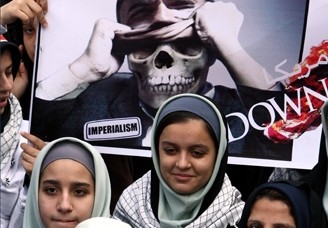Why the Phrase “Arab Spring” Should be Retired
It’s time to stop using a Western-based concept ten years on from the events that began the Arab Uprisings.

A man rides a bicycle past damaged buildings in the rebel-held Tariq al-Bab neighborhood of Aleppo, Syria, September 26, 2016. Abdalrhman Ismail/Reuters
The two-dimensional political continuum connoted by the term “Arab Spring” is unfortunate. The term itself is a holdover from twentieth-century Western media and political thought denoting political change and revolution reminiscent of mid-1800s Europe. As such, we ought to stop using the term “Arab Spring” to describe the events which transformed the Middle East and North Africa (MENA) region between 2010 and 2013 and the successes and failure to bring about socio-political change since then.
The first inconsistency lies in the use of the word “Arab” itself. Certainly, Arabic is a language native to many peoples living in North Africa and the Middle East, but it is not the only language indigenous to the region. While the language does provide some unanimity from Morocco to Iraq and from Oman to Mauritania, the multiethnic richness of the MENA region means that each cultural group and each country has its own languages, traditions, sets of political circumstances, and social and economic aspirations. The Turks (and Turkic peoples), Iranians, Kurds, Berbers, and Yazidis, among others of the Middle East, have not only been directly affected by the revolts in Arabic-speaking communities, but have had social and political upheavals of their own which cannot and should not be seen exclusively within the prism of Arab transformation.
Some may question why the uprisings which began in December 2010—a decidedly non-spring-like month—aren’t referred to as the winter of discontent. Yet, let’s not be overly concrete in our understanding of terminology. “Spring” here takes on something bigger, a metaphorical meaning of newness, growth, recovery, and transformation: these are the things that a political spring can bring to the world, and so too the Arab Spring may be thought of as having ushered in an openness and rebirth of freedom and democracy.
Leaving aside for now the uncertainties of what “freedom” and “democracy” actually mean to different people and political groups on the ground in the MENA region, why did journalists (mostly from Europe and the United States) begin using the term Arab Spring to describe these often violent attempts at political and social transformation in the Middle East and North Africa?
The Political Spring Concept
The dubious credit for the term Arab Spring may be given to writer and academic Marc Lynch, who first used it in a Foreign Policy article on January 6, 2011. However, it is not clear whether Lynch was actually the first person to coin the term. Foreign Policy’s Joshua Keating pointed out later that same year that the term may have been used by U.S. conservative commentators in 2005 to explain movements in the MENA region toward democracy, most notably the Lebanese protests to oust Syrian forces from their country after the assassination of influential politician Rafik Al-Hariri.
But, it is more likely that journalists and political analysts who first used the term “Arab Spring” in those heady days of early 2011 did so as a nod to the “Prague Spring,” which itself was a nod to the 1848 “springtime of peoples” across Europe. Both 1848 and 1968 were years of mass political upheaval in the West.
The Prague Spring began in January 1968 and was an attempt to reverse communism by introducing more liberalized policies in the Eastern European country. However, after eight months, this brief experiment in reformist socialism was crushed by Soviet and Warsaw Pact troops crossing into then-Czechoslovakia and ensuring this spring of liberty would not spread. Soviet leader Leonid Brezhnev proceeded to crack down on all dissidents in the Soviet Union and the rest of Eastern Europe.
This Czech uprising was akin to events that would transpire in Tunisia forty years later in that it was a harbinger for political transformation across Europe and the United States in that seminal year. However, the Prague Spring took place at the height of the Cold War, with the Soviet Union and the United States in competition over Europe, and was therefore defined through Western ideologies and considerations. There were no such influences in Tunisia in 2010, and the youth movement for change there was motivated by different and disparate socioeconomic and political momentums.
In the United States, the capital city of Washington, D.C., came to a standstill after four days of protests and riots in the wake of Martin Luther King Jr.’s assassination in April 1968. The antiracism protests came amid a growing civil rights movement and demonstrations against the increasingly unpopular Vietnam War. With the political tide turning against him, then-President Lyndon Johnson bowed out as the Democratic nominee for reelection, setting up a possible showdown between his rival in the Democratic Party, Robert Kennedy, and Republican Party candidate Richard Nixon. Kennedy’s assassination in June of 1968 left the door open for Nixon’s presidential victory later that year.
In May 1968 French President Charles De Gaulle fled France to Germany, fearing a coup amid unprecedented student and youth protests and civil unrest which shut down the country for nearly five weeks. In Germany, De Gaulle was able to secure the backing of a top French general. He then returned to Paris, dissolved the National Assembly, and called for elections in June. Although De Gaulle would survive the civil unrest and lead France until April 1969, the May 1968 protests changed France’s cultural and social face forever and transformed the relationship between the people and governing institutions.
While the student protesters of 1968 had not won politically, there was an acceptance in Europe and the United States that the cultural war for gender rights, minority rights, and sexual rights—all of which had animated the spirit of 1968—had won. Inversely, the seed of Glasnost—the gradual “opening” of the Soviet Union under Gorbachev—was likely sown in the “Prague Spring,” which would eventually lead to the end of the Soviet statist system, the collapse of the Berlin Wall, and a new world to emerge for Eastern Europeans.
Clearly the Prague Spring was fundamental in the modern history of the United States and Europe. The protests on either side of the Iron Curtain were against statist control and oppression of marginalized groups. There was a stark divide between statist dictators on the one end and the voice of the voiceless on the other. The empowering of peoples seeking more liberties presented Western observers with the dichotomy of “free” people reaching up to shake dictators from their positions of power.
Revolts in the MENA Region over the Past Ten Years
Fast-forward forty-two years to December 2010.
Mass protests in the region began in Tunisia, first on the periphery of critical events in the Arab World such as the Israeli–Palestinian issue and the U.S. invasion and occupation of Iraq. On December 17, 2010, Mohamed Bouazizi—a street vendor in the Tunisian rural city of Sidi Bouzid decrying years of harassment and the unjust confiscation of his property by police officials—set himself on fire in protest.
Bouazizi died from his burns a few weeks later, and Tunisia was thrust into massive oppositional movements which resulted in the fall (and flight to Saudi Arabia) of that nation’s dictator, Zine El Abidine Ben Ali, on January 14, 2011. This was the spark that lit the fire which spread eastward and toppled regimes no one thought would fall, setting the peoples of the Middle East and North Africa on a new path.
Protests spread to Iraq in early 2011, but the government remained in power. Then, in 2014, the Islamic State in Iraq and Syria (ISIS) took over wide swaths of the nation, which resulted in a coordinated international response to eviscerate ISIS from Iraq by the end of 2017. In recent years protests against corruption have continued, and a proxy war between the United States and Iran has intensified with the U.S. targeting armed pro-Iran groups in Iraq.
Kurds living in Turkey, Iran, Iraq, and Syria have all been affected by the events of the past ten years. In Iraq and Syria especially, Kurds fought against ISIS and Kurdish minorities such as the Yazidis suffered greatly at ISIS’ hands. There is now a growing feeling among Kurdish leaders that political independence or regional autonomy within their respective nations is a necessity.
In Syria starting in 2011, there were protests and then a bloody conflict against the Bashar Al-Assad regime. This war resulted in one of the worst humanitarian crises of the twenty-first century when millions of Syrians fled to neighboring countries and Europe. As in neighboring Iraq, ISIS was able to take advantage of the Damascus government’s waning control and occupy much of eastern Syria starting in 2014. Yet, outside influencers, namely Russia and Iran, have helped the state turn the tide, and Damascus looks poised to reestablish Assad’s rule across the country in the near future.
Libya overthrew its dictator of forty-two years, Muammar Gaddafi, at the end of 2011 and since 2014 has been embroiled in a civil war which has become the focal point of many regional and international powers. The majority of the North African country is presently split between forces loyal to the Libyan national House of Representatives and the Libyan National Army and the army loyal to the Government of National Accord. Meanwhile, the European Union, the North Atlantic Treaty Organization, Arab powers, Turkey and Russia have all been active in supporting groups on the ground.
Yemen had gone through a number of civil wars and much civil strife since the south Arabian nation’s unification in 1990. In 2011, an uprising started with common Yemenis and tribal members of the Houthi–Shia minority against the Ali Abdullah Saleh-led state. Protestors complained of economic woes and endemic government corruption. Since 2014 Yemen has devolved into a blood civil war dividing the country into two halves, the north and the south of the country. Saudi Arabia, the United Arab Emirates, and Iran have all had active roles in the war.
Bahrain was wracked by sectarian strife influenced by neighboring Iran as the country’s Shia minority strove for more rights in the Gulf state. The conflict became so rife at one point that Bahrain’s government called for security support from the UAE and Saudi Arabia to quell revolts during a three-month state of emergency in 2011.
Still other nations have had a complete change of government and ruling structure. Tunisia redrafted its constitution after 2011, making it one of the best examples of a democratic system in the region. By 2021 the country has created a political system which incorporates the Islamist party the Ennahda Movement and other leftist parties to create an impressive example of open political discourse for the MENA region.
Meanwhile, neighboring Algeria saw the fall of President Abdelaziz Bouteflika in 2019. Sudan, after years of inactivity, had mass uprisings across the country starting in 2018, which resulted in a power-sharing system led by Prime Minister Abdalla Hamdok.
Other nations, such as Morocco and Jordan, have experienced protests against government policies and rulers have responded with reforms.
Egypt, the largest nation in the Arabic-speaking world, had a prolonged period of mass protests from 2011 to 2013 in which the Muslim Brotherhood President Mohamed Morsi was elected and then ousted from power. Following the protests of 2013, former general Abdel Fattah Al-Sisi became President of the North African nation and has since won reelection in 2018.
Iran has experienced a wave of protests since 2011, with the rise of the coronavirus in 2020 hitting the country particularly hard. Turkey was not initially affected by the protests in the rest of the Middle East in 2011; however, the 2013 Gezi Park Movement against the economic Liberalist policies of the Recep Erdogan-led state and a subsequent failed coup in 2016 were shocks to the country.
Looking at Political Variances on the Ground to See What Will Come Next
Does the term “Arab Spring”—connected as it is to the Westernized concepts of democracy and freedom for the masses as opposed to the oppression of the rulers/dictators—adequately capture the hopes (some shattered) and ambitions of the revolutionaries and instigators of change in the Arab World since Bouazizi’s death?
The connotation of “political spring” is too simplistic and two dimensional to help understand political change. The idea of a political spring may have worked to tell stories and create journalistic and sociological narratives; but, peel back the idea of a political spring and one sees that the “people” strive for power or “democracy” and “freedom.”
Who are the “people,” and what do these masses really want?
The reality is that the process of modernity in MENA-region nations has almost always been connected to elites and the military. Militaries have set up the states, built universities and hospitals. A large number of infrastructural advances have oftentimes been connected to military authority and suzerainty. While dissidents can complain of corruption within militaries, the fact remains that the militaries of the Middle East and North Africa have often been fundamental in transforming their respective nations.
Meanwhile, political Islamism in its various forms is another important voice. Yet, what kind of political Islam do different groups espouse? Some forms of Islamism have been transformed over the years by a healthy relationship with modernity. This kind of Islamism certainly has a place at the table of power brokers in the MENA region. However, some forms of Islamism are animated by violent extremism, and these forms need to be fought against.
In the years since 2010, we saw the massive mobilization of Islamist political ideologies, most affiliated with vicious and violent groups such as Al-Qaeda, ISIS, and their offshoots, which have sought to overthrow governments in Libya, Tunisia, Egypt, Syria, Iraq, and Somalia. These Islamist insurrectionist waves dominated half of the past decade and left the countries where they operated in ruin. Surely there is nothing spring-like about their rise and fall from power.
Ultimately, history and politics have played out much differently in the MENA region than they have in Europe and the United States. Who the rulers are, who the ruled are, what the people want in terms of democracy and freedom are complex and conflicted issues. To then graft events in the Middle East from 2010 to 2013 as part of a western-based political spring paradigm is problematic.
Social change has always been a muddled process. It was muddled in 1848; and in 1968; and it was muddled in 2011. Idealized concepts such as a political spring make us myopic when we need to get down to work after an uprising is over. And so, it is time to leave aside the dualism of political springs and no longer use the term “Arab Spring.”
Ten years on from 2011, the MENA region has transformed. We know not what the future holds: but we can be certain that, when looking at the past and the delicate process of revolt and change, it is necessary to use a political rubric that connects with the realities and variances on the ground so that we can better understand what will come next.
Subscribe to Our Newsletter




